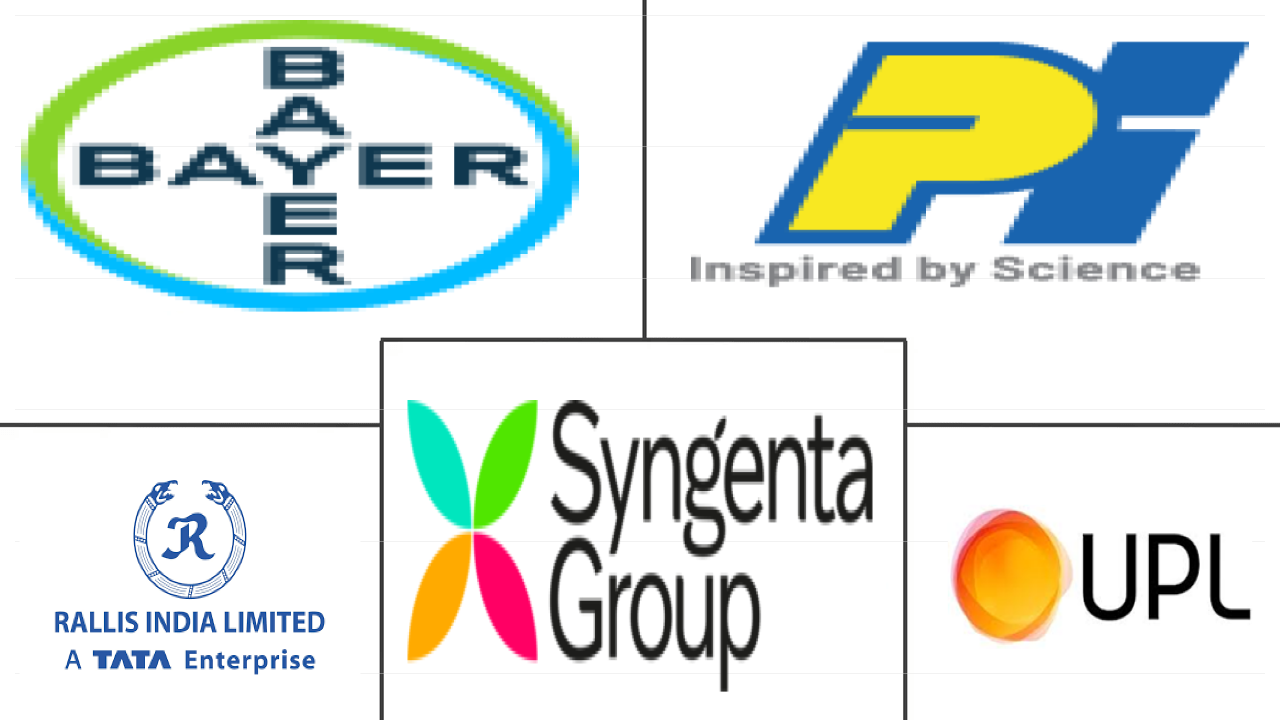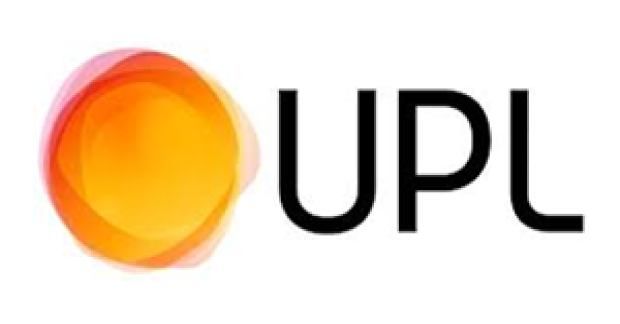Market Size of india fungicide Industry
| Icons | Lable | Value |
|---|---|---|
|
|
Study Period | 2017 - 2029 |
|
|
Market Size (2024) | USD 219.00 Million |
|
|
Market Size (2029) | USD 266.50 Million |
|
|
Largest Share by Application Mode | Foliar |
|
|
CAGR (2024 - 2029) | 4.00 % |
|
|
Fastest Growing by Application Mode | Foliar |
|
|
Market Concentration | Medium |
Major Players |
||

|
||
|
*Disclaimer: Major Players sorted in no particular order |
India Fungicide Market Analysis
The India Fungicide Market size is estimated at 219.00 million USD in 2024, and is expected to reach 266.50 million USD by 2029, growing at a CAGR of 4.00% during the forecast period (2024-2029).
219.00 Million
Market Size in 2024 (USD)
266.50 Million
Market Size in 2029 (USD)
4.18 %
CAGR (2017-2023)
4.00 %
CAGR (2024-2029)
Largest Segment by Application Mode
60.95 %
value share, Foliar, 2023
Farmers can efficiently manage fungal diseases with rapid action for crop health and productivity through foliar application as it directly targets the infected area.
Largest Segment by Crop Type
44.62 %
value share, Grains & Cereals, 2023
Grains and cereals are more susceptible to various fungal diseases, and extending cultivation areas and need to increase productivity, raising fungicide adoption.
Fastest-Growing Segment by Crop Type
4.21 %
Projected CAGR, Commercial Crops, 2024-2029
Increasing demand for these crops in domestic and international markets and increased crop infestation by various disease species increase the fungicide market in these crops.
Leading Market Player 1
14.05 %
market share, UPL Limited, 2022

UPL Limited's product offering includes various fungicide active substances to control fungal diseases like rust, powdery mildew, and white mold, which helps the company's strength.
Leading Market Player 2
12.06 %
market share, Bayer AG, 2022

Bayer focuses on new product launches and improving its distribution channels to provide effective crop protection solutions by partnering with various companies.
The rising fungal diseases are driving the demand for fungicides in various application methods
- Fungicides can be applied using a variety of methods, depending on the specific requirements and diseases. These methods include chemigation, foliar application, fumigation, and seed and soil treatments. These diverse application methods play a crucial role in effectively applying fungicides to various crops, depending on the conditions.
- In 2022, foliar application dominated the fungicide application segment, which held the largest market share of 60.9%. This method was highly preferred as it provides efficient protection against foliar fungal diseases by directly targeting pathogens on leaves. The foliar application facilitates swift penetration and absorption of fungicides into the plant tissues, ensuring their effective action against fungal pathogens.
- Fungicide seed treatments are extensively employed to combat fungal infections in the early stages of plant development. These treatments provide a protective barrier around the seeds, effectively preventing a range of diseases such as seed rots, seedling blights, damping off, and root rots. The fungicide seed treatments segment held a market share of 13.8% in the Indian fungicide market in 2022.
- Grains and cereal crop growers are majorly adopting all the application methods in their cultivation based on the crop stage and insect pests as these crops are more susceptible to insect pests. Foliar insecticide application was majorly adopted by the farmers in these crops.
- The selection of the application mode is influenced by various factors, including the specific target disease, crop type, disease stage, and the availability of equipment. The fungicide market is expected to register a CAGR of 3.9% during the forecast period.
India Fungicide Industry Segmentation
Chemigation, Foliar, Fumigation, Seed Treatment, Soil Treatment are covered as segments by Application Mode. Commercial Crops, Fruits & Vegetables, Grains & Cereals, Pulses & Oilseeds, Turf & Ornamental are covered as segments by Crop Type.
- Fungicides can be applied using a variety of methods, depending on the specific requirements and diseases. These methods include chemigation, foliar application, fumigation, and seed and soil treatments. These diverse application methods play a crucial role in effectively applying fungicides to various crops, depending on the conditions.
- In 2022, foliar application dominated the fungicide application segment, which held the largest market share of 60.9%. This method was highly preferred as it provides efficient protection against foliar fungal diseases by directly targeting pathogens on leaves. The foliar application facilitates swift penetration and absorption of fungicides into the plant tissues, ensuring their effective action against fungal pathogens.
- Fungicide seed treatments are extensively employed to combat fungal infections in the early stages of plant development. These treatments provide a protective barrier around the seeds, effectively preventing a range of diseases such as seed rots, seedling blights, damping off, and root rots. The fungicide seed treatments segment held a market share of 13.8% in the Indian fungicide market in 2022.
- Grains and cereal crop growers are majorly adopting all the application methods in their cultivation based on the crop stage and insect pests as these crops are more susceptible to insect pests. Foliar insecticide application was majorly adopted by the farmers in these crops.
- The selection of the application mode is influenced by various factors, including the specific target disease, crop type, disease stage, and the availability of equipment. The fungicide market is expected to register a CAGR of 3.9% during the forecast period.
| Application Mode | |
| Chemigation | |
| Foliar | |
| Fumigation | |
| Seed Treatment | |
| Soil Treatment |
| Crop Type | |
| Commercial Crops | |
| Fruits & Vegetables | |
| Grains & Cereals | |
| Pulses & Oilseeds | |
| Turf & Ornamental |
India Fungicide Market Size Summary
The India Fungicide Market is poised for steady growth, driven by the country's expansive agricultural sector and the diverse crop types cultivated. With a significant reliance on fungicides to combat fungal diseases that threaten crop yield and quality, the market is experiencing a robust demand. The application of fungicides through various methods such as foliar application, seed treatments, and soil treatments is tailored to address specific crop needs and disease challenges. Foliar application, in particular, has emerged as the dominant method due to its effectiveness in targeting fungal pathogens directly on plant leaves. The increasing crop intensity and the need for effective disease management strategies further bolster the market's expansion, as farmers seek to protect their crops from the adverse effects of fungal infections.
The market landscape is moderately consolidated, with major players like Bayer AG, PI Industries, Rallis India Ltd, Syngenta Group, and UPL Limited leading the charge. These companies are actively enhancing their product offerings and technological capabilities to meet the evolving demands of the agricultural sector. Government initiatives, including subsidies and training programs, are also playing a crucial role in promoting the use of fungicides among farmers. As climatic changes continue to influence disease patterns, the demand for fungicides is expected to rise, ensuring the market's growth trajectory remains positive. The strategic partnerships and investments by key players further indicate a commitment to advancing crop protection solutions in India.
India Fungicide Market Size - Table of Contents
-
1. MARKET SEGMENTATION (includes market size in Value in USD and Volume, Forecasts up to 2029 and analysis of growth prospects)
-
1.1 Application Mode
-
1.1.1 Chemigation
-
1.1.2 Foliar
-
1.1.3 Fumigation
-
1.1.4 Seed Treatment
-
1.1.5 Soil Treatment
-
-
1.2 Crop Type
-
1.2.1 Commercial Crops
-
1.2.2 Fruits & Vegetables
-
1.2.3 Grains & Cereals
-
1.2.4 Pulses & Oilseeds
-
1.2.5 Turf & Ornamental
-
-
India Fungicide Market Size FAQs
How big is the India Fungicide Market?
The India Fungicide Market size is expected to reach USD 219.00 million in 2024 and grow at a CAGR of 4.00% to reach USD 266.50 million by 2029.
What is the current India Fungicide Market size?
In 2024, the India Fungicide Market size is expected to reach USD 219.00 million.

